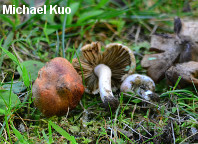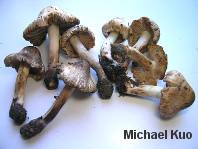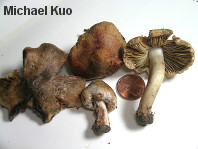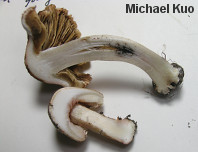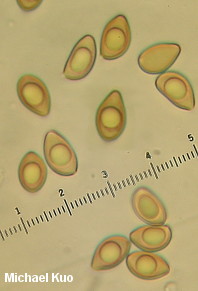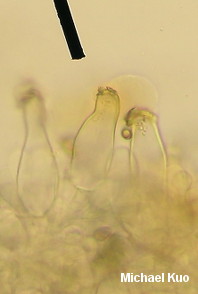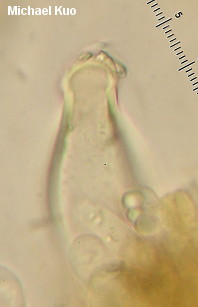| Major Groups > Gilled Mushrooms > Dark-Spored > Inocybe > Inocybe fraudans |

|
Inocybe fraudans [Basidiomycota > Agaricales > Inocybaceae > Inocybe . . . ] by Michael Kuo This distinctive species (or, likely, group of species) can be separated from many similar-looking, whitish to brownish inocybes on the basis of its strong and distinctive odor, which parallels the odor of the well-known "matsutake," Tricholoma murrillianum. Although the odor is sometimes described as being reminiscent of over-ripe pears, I think David Arora's "provocative compromise between 'red hots' and dirty socks" (1986, p. 191) is closer to the mark. Other distinguishing features for Inocybe fraudans include its red-staining surfaces and, under the microscope, its thick-walled pleurocystidia and flask-shaped spores. Inocybe pyriodora, in the sense of many North American authors, is a synonym. Inocybe corydalina is a similar matsutake-smelling species that stains green on its cap and stem and differs microscopically. Description: Ecology: Presumably mycorrhizal; growing alone, scattered, or gregariously in diverse ecosystems from high-elevation conifer forests to low-elevation oak-hickory forests (suggesting there may be several closely related species involved); summer and fall; widely distributed in North America. The illustrated and described collections are from Illinois and Colorado. Cap: 2.5-6 cm; conic, becoming broadly conic to broadly bell-shaped; dry; silky at first, becoming radially lacerated and fibrillose; whitish when very young, becoming brownish yellow to brownish or brown; bruising reddish to red when fresh; the margin inrolled and featuring whitish veil remnants when young. Gills: Narrowly attached to the stem; close; short-gills frequent; whitish, becoming yellowish and eventually brown; bruising reddish when young. Stem: 4-6 cm long; 0.5-1 cm thick; more or less equal above a slightly swollen base; dry; silky or bald; whitish, bruising reddish to red, then slowly brown. Flesh: Whitish; unchanging or, when young, staining slowly pink to reddish when sliced. Odor: Strong, sweet, and fragrant; reminiscent of Tricholoma murrillianum. Chemical Reactions: KOH negative on cap surface. Spore Print: Dull brown. Microscopic Features: Spores 8-11 x 4.5-6.5 µ; amygdaliform; smooth; pale brown and uniguttulate in KOH. Pleurocystidia up to 75 x 15 µ; widely lageniform to widely utriform; apically encrusted; walls often more than 2 µ thick. Cheilocystidia similar but smaller, with walls less than 2 µ thick. Basidia 4-sterigmate. Lamellar trama parallel. Pileipellis a radial cutis; elements brownish- to brown-walled in KOH, finely encrusted, 2.5-10 µ wide, clamped. REFERENCES: (Britzelmayr, 1882) Saccardo, 1887. (Kauffman, 1915; Kauffman, 1924; Smith, Smith & Weber, 1979; Moser, 1983; Weber & Smith, 1985; Arora, 1986; Phillips, 1991/2005; Breitenbach & Kränzlin, 2000; Jacobsson, 2008.) Herb. Kuo 08171406, 08271402. This website contains no information about the edibility or toxicity of mushrooms. |
© MushroomExpert.Com |
|
Cite this page as: Kuo, M. (2015, June). Inocybe fraudans. Retrieved from the MushroomExpert.Com Web site: http://www.mushroomexpert.com/inocybe_fraudans.html |
